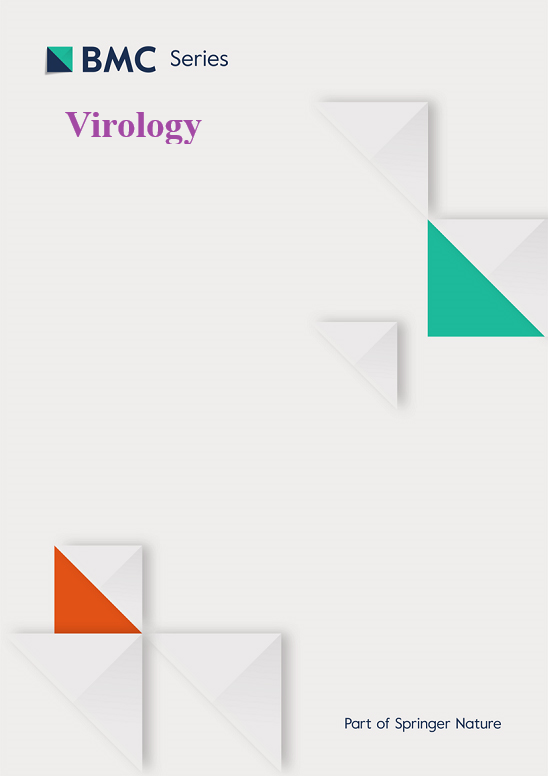A targeted genetic screen identifies Caenorhabditis elegans genes involved in RNAi-independent antiviral defense
IF 2.8
3区 医学
Q3 VIROLOGY
引用次数: 0
Abstract
Cellular organisms are constantly challenged by potentially lethal viral infections and rely on diverse antiviral mechanisms for survival. In several systems, including plants and insects, parallel antiviral pathways provide redundancy, ensuring host protection even if one pathway is compromised by a virus. However, whether such alternative antiviral mechanisms exist in nematodes beyond RNA interference (RNAi) remains largely unexplored. To address this question and as proof of principle, we conducted a small-scale genetic screen to identify C. elegans genes involved in RNAi-independent antiviral defense (RiAD). The reporter system for this screen was a combination of a GFP-tagged flock house virus replicon, as the readout of efficient viral replication, and an RNAi-deficient triple mutant. The reporter C. elegans strain also carried a recessive E3 allele, which suppresses the replication of both flock house virus and Orsay virus. Because this reporter strain lacks a functional RNAi response, any restoration of viral replication in the screen is unlikely due to RNAi disruption, thereby enriching for mutants with defects in RiAD. Upon completing this biased genetic screen we identified ten recessive alleles which were assigned to eight candidate genes. Notably, five of these genes also contributed to RiAD against Orsay virus, indicating a role in broad-spectrum natural antiviral defense. Strikingly, removal of the E3 allele in one of the mutant backgrounds resulted in lethal Orsay virus infection, suggesting that RiAD plays a critical role in protecting C. elegans from fatal viral infection in the absence of RNAi under natural conditions.
一项有针对性的基因筛选鉴定了秀丽隐杆线虫参与rnai非依赖性抗病毒防御的基因
细胞生物不断受到潜在致命病毒感染的挑战,依靠多种抗病毒机制生存。在包括植物和昆虫在内的一些系统中,平行的抗病毒途径提供了冗余,即使其中一条途径被病毒破坏,也能确保对宿主的保护。然而,除了RNA干扰(RNAi)外,线虫中是否存在这种替代抗病毒机制仍未得到充分研究。为了解决这个问题,并作为原理证明,我们进行了一个小规模的遗传筛选,以确定秀丽隐杆线虫参与rnai非依赖性抗病毒防御(RiAD)的基因。该筛选的报告系统是gfp标记的鸡舍病毒复制子(作为有效病毒复制的读数)和rnai缺陷三重突变体的组合。报告秀丽隐杆线虫菌株还携带一个隐性E3等位基因,该等位基因抑制禽舍病毒和奥赛病毒的复制。由于该报告毒株缺乏功能性RNAi应答,因此由于RNAi干扰,在筛选中不太可能恢复病毒复制,从而富集RiAD缺陷突变体。在完成这个偏倚的遗传筛选后,我们确定了10个隐性等位基因,分配给8个候选基因。值得注意的是,其中五个基因也有助于RiAD对抗奥赛病毒,表明其在广谱天然抗病毒防御中发挥作用。引人注目的是,在其中一个突变背景中去除E3等位基因导致了致命的Orsay病毒感染,这表明在自然条件下没有RNAi的情况下,RiAD在保护秀丽隐杆线虫免受致命病毒感染方面发挥了关键作用。
本文章由计算机程序翻译,如有差异,请以英文原文为准。
求助全文
约1分钟内获得全文
求助全文
来源期刊

Virology
医学-病毒学
CiteScore
6.00
自引率
0.00%
发文量
157
审稿时长
50 days
期刊介绍:
Launched in 1955, Virology is a broad and inclusive journal that welcomes submissions on all aspects of virology including plant, animal, microbial and human viruses. The journal publishes basic research as well as pre-clinical and clinical studies of vaccines, anti-viral drugs and their development, anti-viral therapies, and computational studies of virus infections. Any submission that is of broad interest to the community of virologists/vaccinologists and reporting scientifically accurate and valuable research will be considered for publication, including negative findings and multidisciplinary work.Virology is open to reviews, research manuscripts, short communication, registered reports as well as follow-up manuscripts.
 求助内容:
求助内容: 应助结果提醒方式:
应助结果提醒方式:


